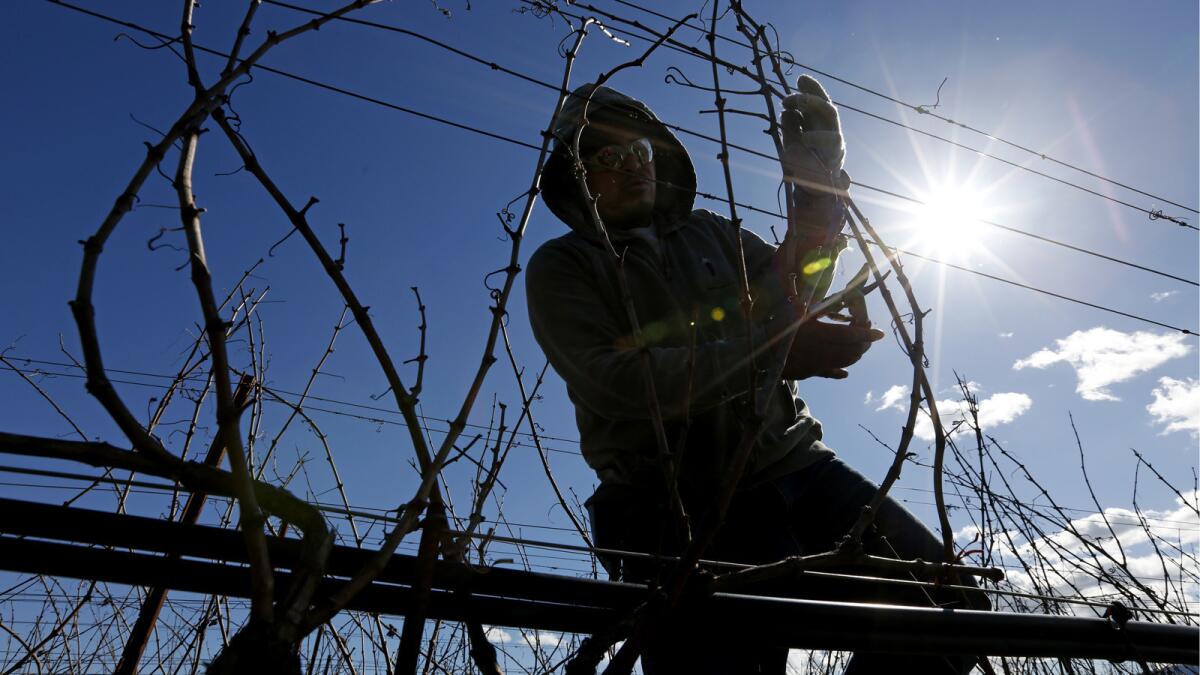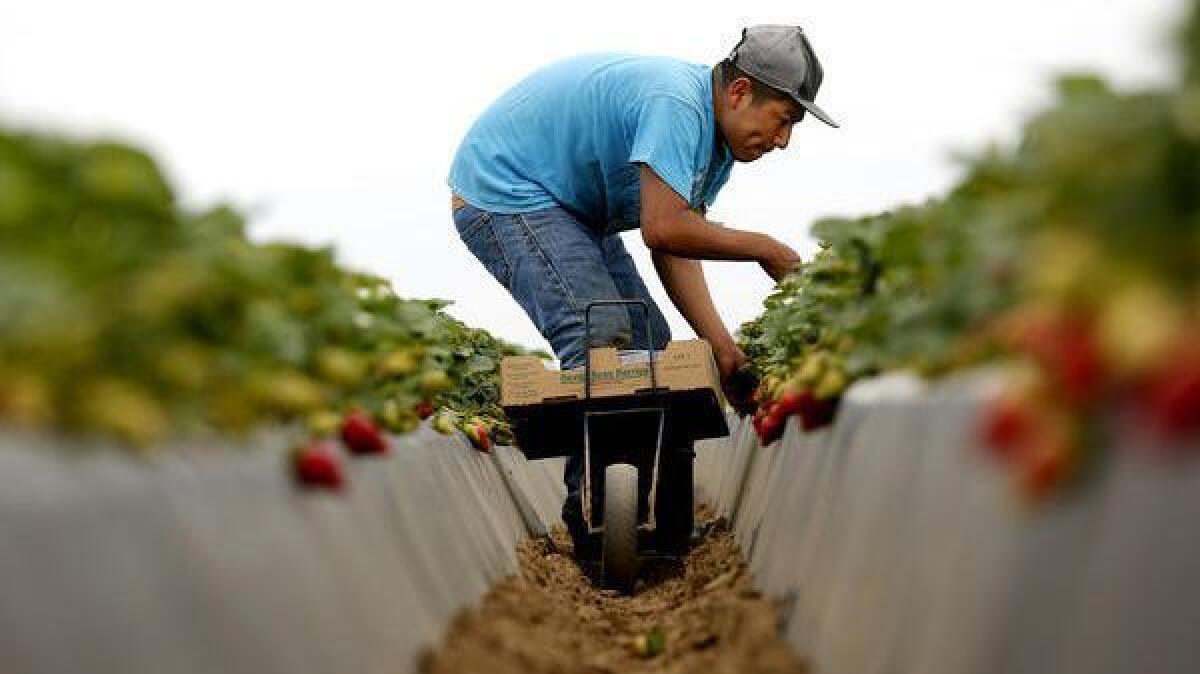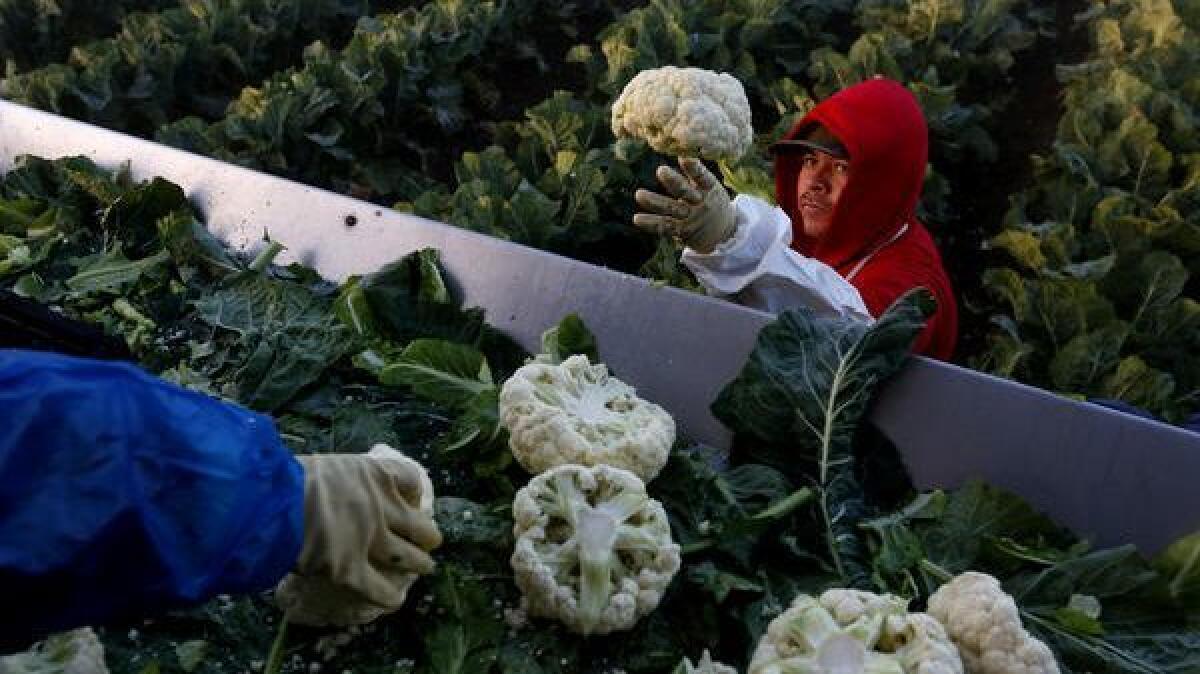Who’s picking your food? A record number of foreign laborers

Recruiters in California’s wine country have been known to drive two hours to Stockton to find farmworkers.
Vineyard manager Chris Bowland went nearly 2,000 miles farther last year — to small villages in the Mexican state of Michoacan, where he recruited a dozen agricultural guest workers under a federal visa program called H-2A.
Bowland’s first foray into the burgeoning foreign guest worker program helped set a record for California in 2017. Growers and contractors here recruited 14,252 foreign guest workers last year, the most they have hired in the program’s modern history, according to a Los Angeles Times analysis of U.S. Department of Labor data.
California’s recruitment of foreign laborers, virtually all of them from Mexico, grew by 3,121 workers, a 28% increase from the previous year, and nearly three times the national growth rate, according to the data analysis.
Since 2011, the state’s recruitment of agricultural guest workers has grown sevenfold. California ranks fifth among states hiring foreign workers, with Georgia and North Carolina topping the list.
The increase comes even as the Trump administration has vowed to clamp down on foreign workers as part of its “America First” agenda to open up more jobs for U.S. citizens.
Native-born workers, though, have not been showing up for field jobs, despite wages that have grown 13% from 2010 to 2015, twice as fast as average pay in the state, a Times analysis shows.
That labor shortage drove Bowland to satisfy his curiosity about the rural villages where many of his workers lived.
“I had always wanted to see where these guys come from, see their hometown and meet their family,” Bowland said. “So it was kind of a bucket-list thing for me. The recruiting was a secondary thing.”
When word got out he was hiring, Bowland had no trouble contracting a dozen workers. “That’s all that I could afford,” he said.
“I could’ve had 60 to 80 guys, easily, that were capable, wanting to work, ready to work,” Bowland said. “So, there isn’t a shortage of people wanting to get involved in this program. There are probably hundreds of thousands of people.”

Bowland employs about 120 people in a season to tend about 500 acres of vineyards. He offers locals about $14 to $15 per hour, he said.
That’s not much more than what he will have to pay guest workers this year — the federal minimum for foreign guest workers in California rose to $13.18, up from last year’s $12.57.
That 4.85% increase that went into effect earlier this month marks the third straight year that guest worker wages rose at rates above the state’s average wage growth. Since 2013, the federally mandated minimum for guest workers in California has increased 22%, according to U.S. Labor Department data.
California’s wage leap was exceeded only by Hawaii and the Oregon-Washington region. Wages are modestly higher in a handful of states where livestock and grain industries dominate, and in the Northwest, where the fruit industry has accelerated its hiring of guest workers.

Bowland is not daunted at paying $13.18 for the Michoacan workers, who will start in April and return home in October. He also will have to provide transportation to get them to Santa Rosa, and housing once they’re here. Those expenses should bring his true hourly costs to at least the $15 he offers local workers, if he can find them.
Guadalupe Sandoval, managing director of the California Farm Labor Contractors’ Assn., said California’s guest worker wage hike will hurt regions that still offer locals the $10.50 to $11 minimum wage, such as the Central Valley.
“That’s a nice little jump,” he said. “But if you’re up in Santa Rosa, that’s probably $2 to $3 down from the regular wage.”
Even at $16 per hour, contractors and vineyard owners can’t fill their work crews, Sandoval said.
“There’s a lot of good jobs, but not in areas where it’s affordable to live,” Sandoval said. “Workers are driving two hours each way now.”
That affordability gap has only grown more acute in wine country, where wildfires razed 10,000 homes last year. The median rent in Sonoma County rose 36% to $3,224 a month since September, before the fires, according to Zillow Research.
Once the rebuilding effort gets underway, the construction industry may lure workers out of the vineyards.
“You’re going to have a huge demand for semi- and unskilled labor in the construction industry,” said Bowland. “If that wasn’t bad enough, we just legalized marijuana, and they’re building greenhouses like there’s no tomorrow. And they’re going to need people to work in those greenhouses.”
So, this weekend, Bowland will head back to Michoacan.
“I probably have 20 people waiting for me,” he said. “And I’ll probably have 20 or 30 more in an hour.”
Twitter: @LATgeoffmohan
UPDATES:
12:30 p.m.: This article was updated with context about where California ranks in H-2A hiring.
This article was originally published at 12:15 p.m.
More to Read
Inside the business of entertainment
The Wide Shot brings you news, analysis and insights on everything from streaming wars to production — and what it all means for the future.
You may occasionally receive promotional content from the Los Angeles Times.











